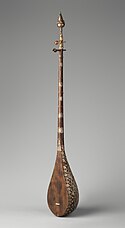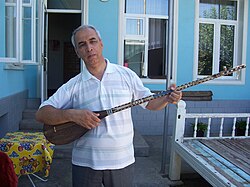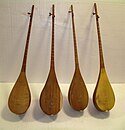Musical Instruments and Musicians. A Man Playing a Dutar, a Long-Necked Fretted Lute
Autor:
Kun, Aleksandr L., 1840-1888
Shortlink:
Zdroj:
Formát:
1374 x 1024 Pixel (1926575 Bytes)
Popis:
This photograph is from the ethnographical part of Turkestan Album, a comprehensive visual survey of Central Asia undertaken after imperial Russia assumed control of the region in the 1860s. Commissioned by General Konstantin Petrovich von Kaufman (1818–82), the first governor-general of Russian Turkestan, the album is in four parts spanning six volumes: “Archaeological Part” (two volumes); “Ethnographic Part” (two volumes); “Trades Part” (one volume); and “Historical Part” (one volume). The principal compiler was Russian Orientalist Aleksandr L. Kun, who was assisted by Nikolai V. Bogaevskii. The album contains some 1,200 photographs, along with architectural plans, watercolor drawings, and maps. The “Ethnographic Part” includes 491 individual photographs on 163 plates. The photographs show individuals representing the different peoples of the region (Plates 1–33); daily life and rituals (Plates 34–91); and views of villages and cities, street vendors, and commercial activities (Plates 92–163).
Ethnographic photographs; Musical instruments; Musicians; Photographic surveys; Portrait photographs; Portraits; Turkic peoples
Ethnographic photographs; Musical instruments; Musicians; Photographic surveys; Portrait photographs; Portraits; Turkic peoples
Licence:
Public domain
Credit:
Relevantní obrázky
Relevantní články
DutarDutār je tradiční perský drnkací strunný nástroj (chordofon). Jedná se o typ taru. Slovo dutār pochází z perštiny (دوتار) a doslovný překlad je „dvě struny“, kde du (دو) znamená „dvě“ a tar (تار) „struna“, ačkoli herátský dutar z Afghánistánu má struny tři. Kromě dutāru ještě rozlišujeme třístrunný setār (سهتار), čtyřstrunný tār (تار), pětistrunný penčtār (پنجتار) a šestistrunný šeštār (ششتار). .. pokračovat ve čtení











